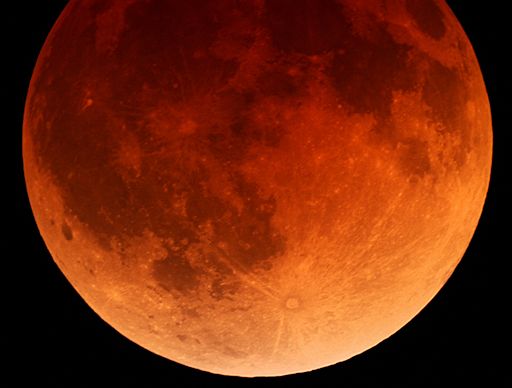From: http://spaceweather.com
DON'T MISS THE LUNAR ECLIPSE: On Wednesday morning, Oct. 8th, there will be a total lunar eclipse.
Sky watchers in the Americas, Australia and most of Asia can see the
full Moon turn red as it passes through the sunset-colored shadow of
Earth: visibility map.
The show begins at approximately 9:15 UT (2:15 a.m. PDT) when the Moon
makes first contact with the core of Earth's shadow. Totality, when the
Moon is fully shadowed, begins at 10:25 UT (3:25 a.m. PDT) and lasts
for nearly an hour. Resources: NASA video, animated eclipse, live webcast.
During the eclipse, the Moon will look like this:
The hue of the lunar disk
may seem puzzling to some readers. Shadows are supposed to be black, yet
the shadowed Moon is mostly bright red. A quick trip to the Moon
explains the color:
Imagine yourself standing
on a dusty lunar plain looking up at the sky. Overhead hangs Earth,
nightside down, completely hiding the sun behind it. The eclipse is
underway. You might expect Earth seen in this way to be utterly dark,
but it's not. The rim of the planet is on fire! As you scan your eye
around Earth's circumference, you're seeing every sunrise and every
sunset in the world, all of them, all at once. This incredible light
beams into the heart of Earth's shadow, filling it with a coppery glow
and transforming the Moon into a great red orb.
Red isn't the only color,
however. Sharp-eyed observers might also spot some turquoise, shown here
in a photo taken by Jens Hackman during an eclipse in March of 2007:
Its source is ozone.
Atmospheric scientist Richard Keen of the University of Colorado
explains: "During a lunar eclipse, most of the light illuminating the
moon passes through the stratosphere where it is reddened by
scattering. However, light passing through the upper stratosphere
penetrates the ozone layer, which absorbs red light and actually makes
the passing light ray bluer." This can be seen, he says, as a soft
blue fringe around the red core of Earth's shadow.
To catch the turquoise on Oct. 8th, he
advises, "look during the first and last minutes of totality. The
turquoise rim is best seen in binoculars or a small telescope."

No comments :
Post a Comment